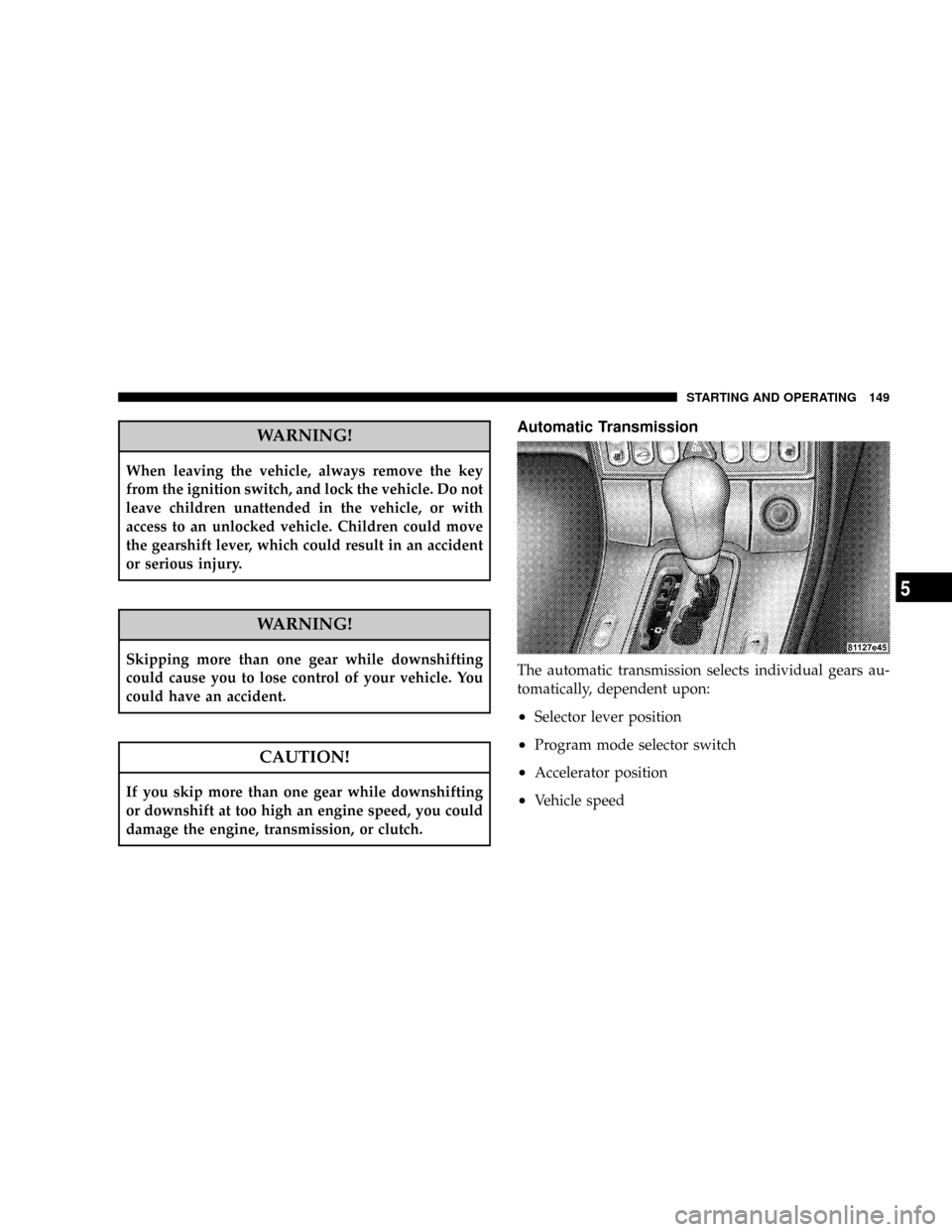CHRYSLER CROSSFIRE 2007 1.G Owners Manual
Manufacturer: CHRYSLER, Model Year: 2007, Model line: CROSSFIRE, Model: CHRYSLER CROSSFIRE 2007 1.GPages: 299, PDF Size: 8.26 MB
Page 141 of 299

Operating Tips
UNDERSTANDING YOUR INSTRUMENT PANEL 141
4
Page 142 of 299

Page 143 of 299

STARTING AND OPERATING
CONTENTS
mStarting Procedures....................145
NNormal Starting......................145
NExtremely Cold Weather
(Below -20ÉF Or -29ÉC).................146
NIf Engine Fails To Start.................146
NAfter Starting........................147
mTransmission Shifting...................147
NManual Transmission..................147
NRecommended Shift Speeds..............148
NAutomatic Transmission................149
NStopping...........................150
NManeuvering........................151NPark Position........................151
NReverse............................152
NNeutral............................152
NDrive..............................152
NAutoSticktGear Selection...............152
NGear Ranges.........................154
NProgram Mode Selector Switch............154
NEmergency Operation (Limp Home Mode) . . . 155
mParking Brake.........................156
mBrake System.........................157
NBrake Assist System (BAS)...............157
NElectronic Stability Program (ESP).........159
5
Page 144 of 299

NSynchronizing ESP....................161
NESP Control Switch....................161
NAnti-Lock Brake System (ABS)............162
NBrake Pad Break-In....................166
mPower Steering........................166
mTire Safety Information..................167
NTire Markings........................167
NTire Identification Number (TIN)..........170
NTire Loading And Tire Pressure...........171
mTiresÐGeneral Information...............175
NTire Pressure.........................175
NTire Inflation Pressures.................176
NRadial-Ply Tires......................178
NTire Spinning........................178
NTread Wear Indicators..................179
NReplacement Tires.....................179
NAlignment And Balance.................181
mTire Pressure Monitor System (If Equipped). . 181
NGeneral Information...................183
mTire Chains...........................183
mOriginal Equipment Tires................184
mSnow Tires...........................184
mTire Rotation Recommendations...........185
mFuel Requirements.....................186
NReformulated Gasoline.................187
NGasoline/Oxygenate Blends..............187
NMMT In Gasoline.....................188
NMaterials Added To Fuel................188
NSulfur In Gasoline.....................188
mAdding Fuel..........................189
NFuel Filler Cap (Gas Cap)...............189
mVehicle Loading.......................191
NRoof Luggage Rack....................191
mTrailer Towing........................192
144 STARTING AND OPERATING
Page 145 of 299

STARTING PROCEDURES
WARNING!
Do not leave animals or children inside parked
vehicles in hot weather; interior heat build up may
cause serious injury or death.
Be sure that the parking brake is engaged and that
selector lever is in the NEUTRAL or PARK position
(gearshift lever in Neutral). Turn the key in the ignition
switch to the ON/RUN position. Apply the brakes before
shifting into any driving gear.
Normal Starting
Vehicles with automatic transmissions:
Do not depress the accelerator. Simply turn the key in the
ignition switch clockwise to the START position andrelease when the engine starts. If the engine will not run,
turn the key counterclockwise to the OFF/LOCK posi-
tion and repeat the starting procedure. If there are several
unsuccessful attempts, have the system checked at the
nearest authorized dealer.
Vehicles with manual transmissions:
Do not depress the accelerator. Fully depress the clutch
pedal, otherwise the engine cannot be started due to the
integrated safety interlock. Simply turn the key in the
ignition switch clockwise to the START position and
release when the engine starts. The starter will engage
until the engine is running. If the engine will not run,
turn the key counterclockwise to the OFF/LOCK posi-
tion and repeat the starting procedure. If there are several
unsuccessful attempts, have the system checked at the
nearest authorized dealer.
STARTING AND OPERATING 145
5
Page 146 of 299

NOTE:Due to the starter non-repeat feature, the key
must be turned completely to the left before attempting
to start the engine again.
Extremely Cold Weather (below -20ÉF or -29ÉC)
For reliable starting in areas where temperatures fre-
quently drop below -20ÉF (-29ÉC), we recommend the use
of an externally powered battery and an electric engine
block heater. Advice on these items and installation is
available at your authorized dealer.
If Engine Fails to Start
CAUTION!
Do not try to push or tow your vehicle to get it
started. Your vehicle cannot be started this way.
Pushing with another vehicle may damage the trans-
mission or the rear of your vehicle. See Section 6 of
this manual for proper jump-starting procedures.
WARNING!
Never pour fuel or other flammable liquid into the
throttle body air inlet opening in an attempt to start
the vehicle. This could result in a flash fire, causing
serious personal injury.
If the engine fails to start after you have followed the
Normal Starting procedure, it may be flooded. Push the
146 STARTING AND OPERATING
Page 147 of 299

accelerator pedal all the way to the floor and hold it there
while cranking the engine. This should clear any excess
fuel in case the engine is flooded.
CAUTION!
To prevent damage to the starter, do not crank the
engine for more than 15 seconds at a time. Wait 10 to
15 seconds before trying again.
If the engine has been flooded, it may start to run, but not
have enough power to continue running when the key is
released. If this occurs, continue cranking with the accel-
erator pedal pushed all the way to the floor. Release the
accelerator pedal and the key once the engine is running
smoothly.
If the engine shows no sign of starting after two 15-
second periods of cranking with the accelerator pedal
held to the floor, the Normal Starting procedure should
be repeated.
After Starting
The idle speed will automatically decrease as the engine
warms up.
TRANSMISSION SHIFTING
Manual Transmission
NOTE:
The parking brake should be engaged and the
gear selector placed in REVERSE before leaving the
vehicle, especially on an incline. To place the transmis-
sion in REVERSE, lift up on the shifter knob, push it to
the left and pull it back.
STARTING AND OPERATING 147
5
Page 148 of 299

Fully depress the clutch pedal before you shift gears. As
you release the clutch pedal, lightly depress the accelera-
tor pedal.
Be sure the transmission is in FIRST gear, (not THIRD),
when starting from a stopped position. Damage to the
clutch can result from starting in THIRD.
NOTE:If there is a need to restart your engine, you
must recycle your ignition switch to the OFF position
before restarting the engine.
For most city driving, you will find it easier to use only
the lower gears. For steady highway driving with light
accelerations, sixth gear is recommended.
Never drive with your foot resting on the clutch pedal, or
try to hold the vehicle on a hill with the clutch pedal
partially engaged. This will cause abnormal wear on the
clutch.
Never shift into REVERSE until the vehicle has come to a
complete stop.
NOTE:During cold weather, until the transmission
lubricant has warmed, you may have difficulty shifting.
This is normal and not harmful to the transmission.
Recommended Shift Speeds
To use your manual transmission for both fuel economy
and performance, it should be upshifted as shown in the
chart. Shift at the vehicle speeds listed for acceleration.
Earlier upshifts during cruise conditions (relatively
steady speeds) will result in increased fuel economy, and
may be used as indicated.
Higher upshift speeds may be used to obtain a desired
acceleration rate.
MANUAL TRANSMISSION
RECOMMENDED SHIFT SPEEDS
1-2 2-3 3-4 4-5 5-6
MPH 15 25 40 45 50
(km/h) (24) (40) (64) (72) (80)
148 STARTING AND OPERATING
Page 149 of 299

WARNING!
When leaving the vehicle, always remove the key
from the ignition switch, and lock the vehicle. Do not
leave children unattended in the vehicle, or with
access to an unlocked vehicle. Children could move
the gearshift lever, which could result in an accident
or serious injury.
WARNING!
Skipping more than one gear while downshifting
could cause you to lose control of your vehicle. You
could have an accident.
CAUTION!
If you skip more than one gear while downshifting
or downshift at too high an engine speed, you could
damage the engine, transmission, or clutch.
Automatic Transmission
The automatic transmission selects individual gears au-
tomatically, dependent upon:
²Selector lever position
²Program mode selector switch
²Accelerator position
²Vehicle speed
STARTING AND OPERATING 149
5
Page 150 of 299

The gear shifting process is continuously adapted, de-
pendent on the driving style, the driving situation and
the road characteristics.
The selector lever is automatically locked while in the
PARK position. To move the selector lever out of the
PARK position, the brake pedal must be firmly depressed
before the shift lock will release.
Shift the selector lever to the desired position only when
the engine is idling normally and the brake pedal is
applied. Do not release the brake until ready to drive. The
vehicle may otherwise accelerate quickly when the selec-
tor lever is in DRIVE or REVERSE position.
NOTE:After selecting any driving position, wait a
moment to allow the gear to fully engage before acceler-
ating, especially when the engine is cold.
WARNING!
It is dangerous to shift the selector lever out of PARK
or NEUTRAL if the engine speed is higher than idle
speed. If your foot is not firmly on the brake pedal,
the vehicle could accelerate quickly forward or in
reverse. You could lose control of the vehicle and hit
someone or something. Only shift into gear when the
engine is idling normally and when your foot is
firmly on the brake pedal.
Stopping
For brief stops, leave the transmission in gear and hold
the vehicle with the brake pedal. For longer stops with
the engine idling, shift into the NEUTRAL or PARK
position and hold the vehicle with the parking brake.
When stopping the vehicle uphill, do not hold it with the
accelerator; use the brake. This avoids unnecessary trans-
mission heat build-up.
150 STARTING AND OPERATING